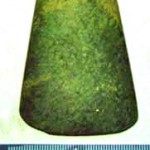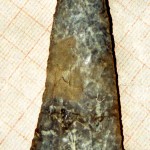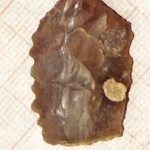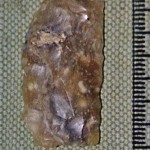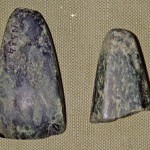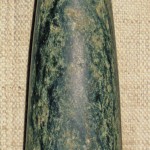Aeneolithic
Stone Age monuments aren’t fixed in this area. It is difficult to say whether this territory was unsuitable to live there, due to had nature conditions and problems with sources of food to a prehistoric man, or it is connected with the destruction of prehistory monuments due to natural disasters. We remind the people that on the adjacent areas there are monuments of Stone Age different periods, starting with the Mousterian Stone Age.
On settling in the Abrau peninsula in Aeneolithic ‒ Early Bronze Age testifies a number of facts. On the coast, it is a longtime Myskhako I settlement, relating to the culture of ceramic «pearl» ornament. On the opposite small slopes of the site of the Caucasus ridge (300‒600 m high) the existence of similar or close sites to be mentioned is due to occidental finds. Thus, a variety of different regular finds of stone tools (axes, flint tools, as well as waste products ‒ flakes and chips) were met several times during excavations of the Raievski Hillfort. It is possible fragments of grain grinders date that to that time. Unfortunately, the non-ruined cultural layer of that period is still to discover and explore. During 2001 three Raievski sites were found in the vicinity of the settlement. Very close to it in the floodplain of the Maskaga river it had been found large polished adze of the serpentine, it’s kept at the Rayevski Stanitsa school museum.
In the cultural layer of the Raievskaya 4 settlement they had found two fragments of the tool: pieces of the knife (or insert, or the tip of the arrow?) and typologically little-looking knife, made of small semi-transparent gray flint flake.
The third location was found during the excavation of the burial mound, situated 0.7 km of the SSW of the Raievski Hillfort.
From the central burial they had found materials that can be dated back to the Copper Age ‒ Early Bronze Age. Among the flint implements we note a pad of reaping tool made of translucent grayish brown flint, it has a correct rectangular shape (3.2×1.8×0.5 cm), processed on both sides by flat neat retouch over the entire surface, and the facet retouch on both sides of the blade. They have a distinct polish characteristic of tools, long used for cutting straw. The waste production of flint tools had been found: a very rough and irregular plate chipping dark gray opaque flint, one of the long edges of flint is covered on one side by 2/3 the length of the edge is a very small retouch, indicating the use of the object as a cutting instrument, and ribbed peeling gray-brown translucent flint, downed with a small nucleus.
In the southwestern part of the mound in overlapping burial 3 we have found a fragment of polished serpentine-adze. The tool had a narrow, almost acuminate butt absolutely flat abdomen, rounded arched, beveled side faces to the abdomen. The cross-section look like a pentagon with a rounded angle, namely from the side of the backrest. This feature shows that the tool was almost identical to that described above the serpentine-adze from the Maskaga floodplain.


